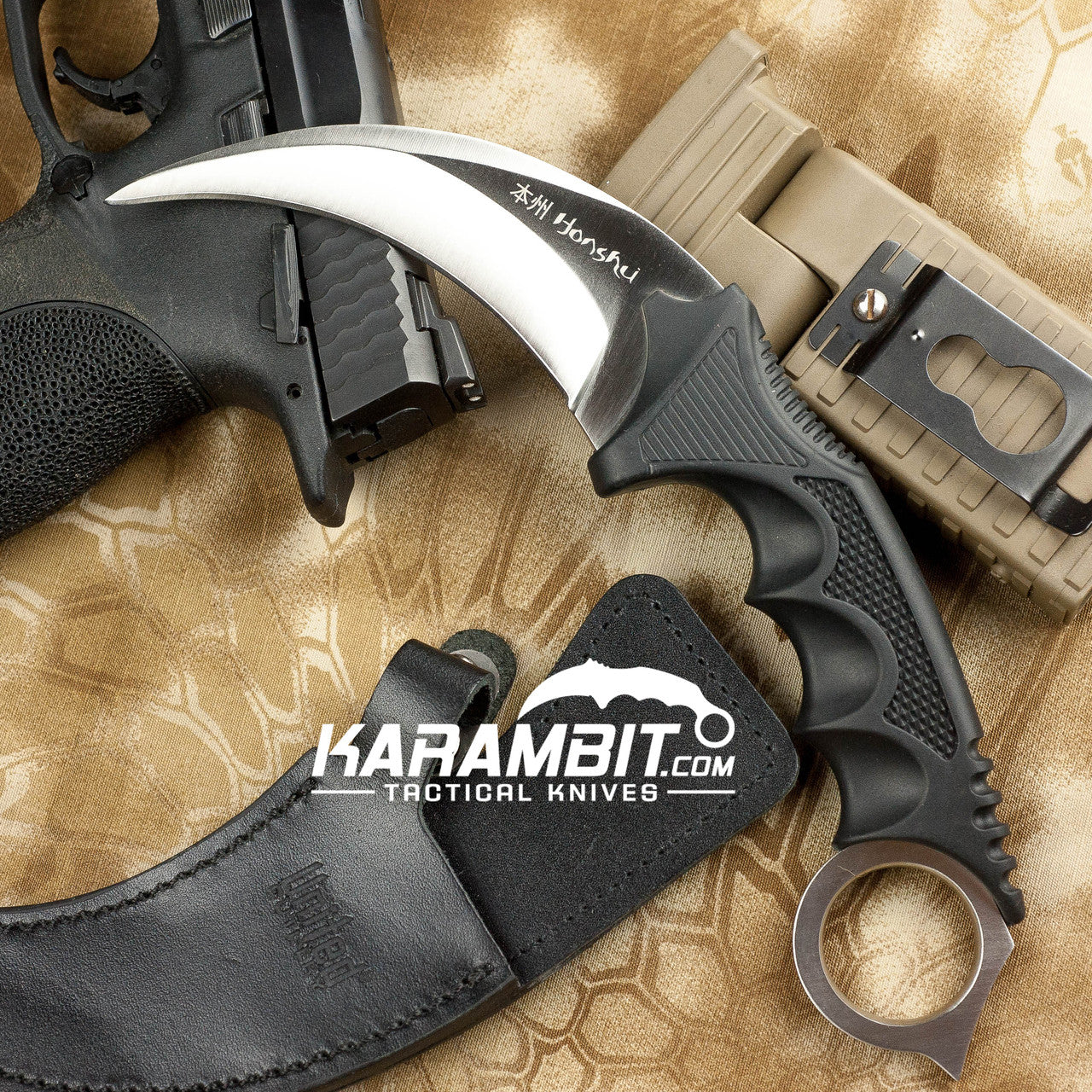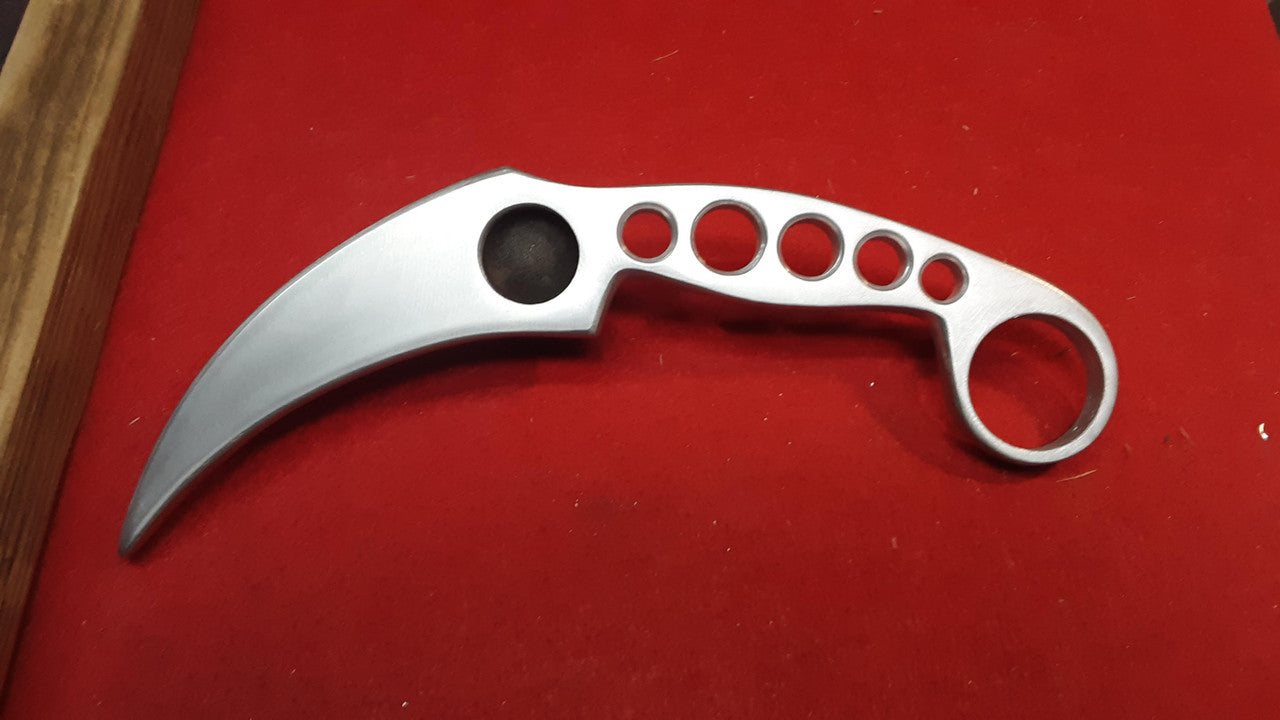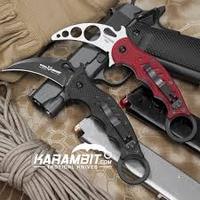As far as knives go, the "claw blade" of Southeast Asia, more commonly known as the Karambit, is incredibly remarkable. From the design to its use, everything about this curved knife is unique.
These Indonesian weapons are particularly special due to the fact that they can cut three times in one pass in the form of a double edge fixed blade. This extra cut can make the training with a karambit an eye opening experience for even a seasoned martial artist. Below I will explain how to deploy a fixed blade karambit and correctly execute a triple cut on one pass. I will also explore a few deployments with a modern folding karambit equipped with an Emerson wave opener and the several gripping options open to the blade holder while accessing and deploying this knife.
A student of traditional Harimau Silat will normally keep their karambit tucked in the top roll of their sarong; this position makes the blade accessible during a confrontation. With the development of high tech materials such as ultra lightweight carbon fiber and super strong plastic composites, the ability to mount a karambit on the body has become the preferred method of carry for the wearer than the adherence to tradition. the techniques for drawing the knife can be modified to fit the user’s modern needs.
Waist Band Deployment
First, let's look at a waist band deployment for the fixed blade karambit with a crossing hand. Remember this is a traditional technique from an esoteric martial art from Sumatra. It’s important to understand the legal and moral obligations of using the karambit in this way as this technique was developed for actual fighting as opposed to hunting or whittling.

As you complete the drawing motion with the karambit extended, the first cut accompanies the draw. Then, bend your elbow and bring your hand back to your chest. This is your 2nd cut. Afterwards, retract the karambit to perform the 3rd cut on that back and forth pass. Please check the supplementary video for any clarification. After the draw, return to a defensive posture and look in both directions before resetting.
We will now delve into using a more modern incarnation of the karambit. This example will use a fox 479 folding karambit featuring an Emerson Wave Opener on the blade spine. The wave opener is designed to hook onto the pocket and instantly open the blade of the knife into a locked and ready position as it is deployed from the pocket. There are multiple places from which the knife can be mounted and the wave opener utilized. The video demonstrates a few variations of these. For the sake of this article and the video I will spend most of my time working with my Fox 479 karambit mounted in my front pocket.
the first deployment will be by drawing the knife while utilizing the wave opener to come into a defensive posture with the karambit’s blade in the open and ready position. As I access the ring of the knife, I lay my second, third and forth fingers over my pocket as the index finger gets a deep grip on the ring. I draw the knife out and away from my body engaging the opener. As my arm extends, I wrap my fingers around the handle of the knife and raise my opposite hand to arrive in a defensive fighting stance.

The second deployment will end with the blade in the extended position. As I access the ring of the knife with my index finger, I get a tight, deep grip. I then make a fist behind the ring and draw the blade out in front and away from my pocket. It is necessary to keep a tight grip on the ring with your fingers or the blade will wiggle and may not be in the position you want once your arm is extended. Bring up the opposite hand and adopt a defensive fighting stance. This deployment is a longer range opening, and you should end up with the karambit in front of your body, similar to a cross punch from boxing.

The final deployment of this section will be the flashy one, an extended to retracted, or a flipping, open. This is basically a blend of the two mentioned above. Just as with the extended deployment, you adopt the grip with your index finger in the ring and the others in a fist behind the ring. Next, draw the knife up and away while opening your fingers as your arm travels to your defensive posture. The knife will exit the pocket and flip over the index finger, landing in the palm ready for you to close your hand around the handle. You should finish in the defensive posture with the knife up by your head and your left arm up, again similar to boxing.
The purpose of these articles are to educate you and your training partners in a way that allows you to utilize your tools without hurting yourself or others while training. A training blade is the first karambit one should ever begin to work with. Please remember that the karambit moves like no other modern knife, and much care should be taken while developing your skills with the feral curved blade, known as the karambit. Take a look at the selection of training tools offered on the site and find the one that is right for you: http://www.karambit.com/shop/training-gear
Thank you for reading this and watching the video!
Lakan Guro Chris Caban is the Chief Instructor of the Atlanta Kali Group. He has 16 years of training in the Filipino Martial Arts, a Brown Belt in Brazilian Jiu-Jitsu, 9 years of Muay Thai, 7 years of Mande Muda Silat, 9 years Folk/Freestyle Wrestling, and over 5 years of Tactical Training with Local Law Enforcement. Chris was also the head instructor of Carlson Gracie Guatemala (2010-2011), and currently is the director of the Dojo American Karate Center in Dacula, Ga.







